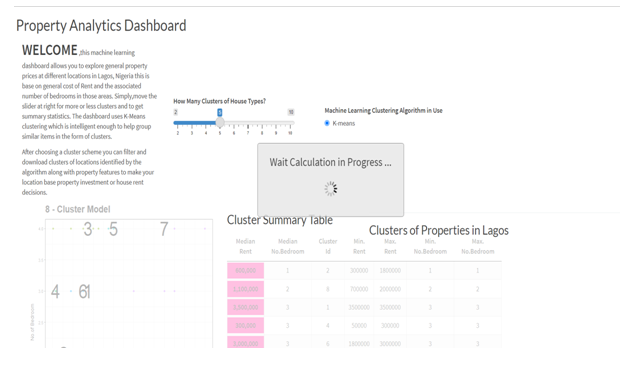Machine Learning Dashboard for Property Analytics
Overview of Solution
We designed a machine-learning clustering dashboard that allows you to explore general property rent or prices at different locations in Lagos, Nigeria. This also includes a breakdown of other features such as the number of bedrooms, bathrooms, and toilets. After choosing a cluster scheme you can filter and download clusters of houses at different locations along with the features of the houses identified by a machine-learning algorithm to make your location base property investment or house rent decisions.
Challenge
Individuals and real estate agents or companies do have tough and long hours browsing through lists of houses listed on property websites in Nigeria. While these websites may have options to get a particular house type, these are mostly done through manual clicks of various buttons, and even when the filtering is done, the house data or information cannot be visualized and are not made available for a one-time download.
Our Solution solves this problem by taking in housing data and using a machine learning solution to perform a one-time clustering or segmentation and to make the resultant segmentation downloadable for onward housing decisions and for more insights via an interactive dashboard. More also, machine learning techniques are quite more intuitive than manual sorting.
Approach and Functions
The dataset used for this project was collected by our team of Data Scientists. They carried out web scraping. The web scraping was done using sophisticated python programming and formatted to be suitable for this project.
Afterward, the data was loaded into R Studio which is an integrated development environment for coding in R . Various data processing was done and K-Means clustering which is an intelligent machine learning algorithm was set up on the data for real-time clustering or segmentation. To enable user interaction with the solution, R Shiny was used to develop an interactive dashboard that takes user inputs and uses machine learning to perform clustering of houses automatically based on user options and make the outcome downloadable, and users can also filter based on clusters or house features through an interactive dashboard. Below are the screenshots of the working application.



User Interfaces of Web Applications and Functions
Other Areas of Application
Other areas where this solution can be adopted include the following:
Marketing: This solution can be used for customer segmentation, which is a process of dividing customers into different groups based on their behaviour or characteristics. Customer segmentation can help optimize marketing campaigns, reduce targeting the wrong segment of customers, and can be used to achieve appropriate product pricing and recommendations. Our machine learning-powered dashboards can help businesses find customer segments that would be very difficult to spot through human intuition and manual examination of data.
Financial Transactions: This solution uses a machine-learning clustering technique which can also be used in the detection of fraud or financial anomalies. As a data mining function, cluster analysis serves as a tool to gain insight into the distribution of data to analyze the characteristics of each cluster. This can help group similar behaviours. Based on the characteristics of the groups or clusters a company will be able to identify transactions that are real and those that are suspicious.
Other Company Operations: The challenge here is that most times companies do not know the best approach to take when it comes to some of their operations. Using the machine learning clustering technique, an interactive dashboard can be developed that can help find potential employees for hire, investment options, maintenance options, marketing, and sales options and can help perform other tasks that require segmentation. This can be done using clustering algorithms. Ultimately this means a company can make a quality decision quickly thereby saving time and optimizing performance.
